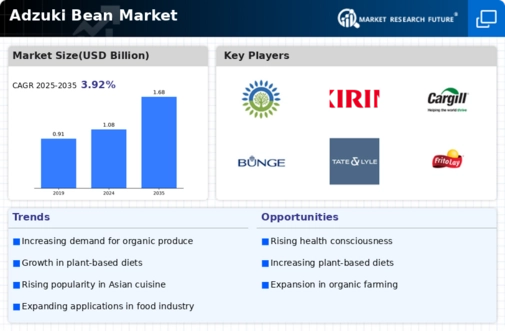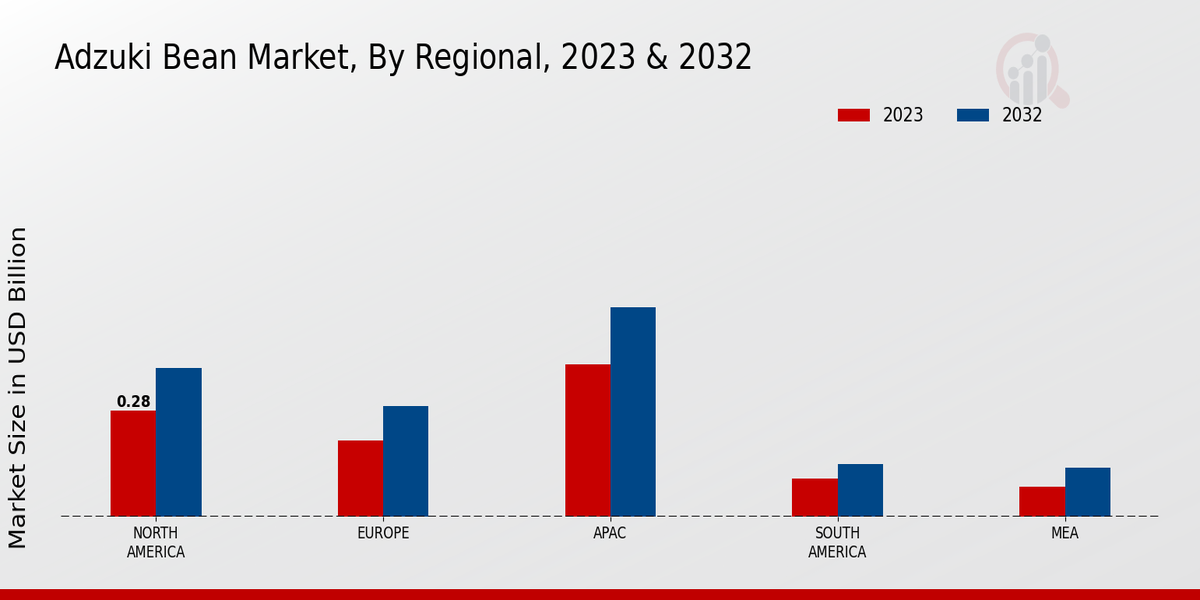Culinary Versatility
Adzuki beans are celebrated for their culinary versatility, which appears to be a significant factor driving the Global Adzuki Bean Market Industry. They are utilized in various cuisines, particularly in Asian dishes, where they are featured in desserts, soups, and salads. This adaptability not only appeals to traditional consumers but also attracts a younger demographic interested in diverse culinary experiences. The integration of adzuki beans into modern recipes and food products, such as snacks and protein bars, suggests a growing market potential. As culinary trends evolve, the demand for adzuki beans is likely to increase, contributing to a projected CAGR of 4.12% from 2025 to 2035.
Market Growth Projections
The Global Adzuki Bean Market Industry is projected to experience substantial growth, with estimates indicating a market value of 1.08 USD Billion in 2024 and a potential increase to 1.68 USD Billion by 2035. This growth trajectory suggests a compound annual growth rate (CAGR) of 4.12% from 2025 to 2035. Such projections reflect the increasing demand for adzuki beans driven by health trends, culinary versatility, and sustainable practices. The market's expansion is likely to be supported by both domestic and international demand, as consumers continue to seek nutritious and environmentally friendly food options.
Rising Health Consciousness
The increasing awareness of health and wellness among consumers appears to be a primary driver of the Global Adzuki Bean Market Industry. Adzuki beans are recognized for their high nutritional value, including protein, fiber, and essential vitamins. This trend is particularly evident in regions such as North America and Europe, where consumers are actively seeking plant-based protein sources. As a result, the demand for adzuki beans is projected to contribute to the market's growth, with an estimated value of 1.08 USD Billion in 2024. This shift towards healthier eating habits is likely to sustain the industry's expansion over the coming years.
Innovative Product Development
The Global Adzuki Bean Market Industry is witnessing a surge in innovative product development, which appears to be a key driver of market growth. Manufacturers are increasingly exploring new ways to incorporate adzuki beans into various food products, including snacks, beverages, and ready-to-eat meals. This innovation not only caters to the evolving tastes of consumers but also enhances the nutritional profile of products. The introduction of adzuki bean-based protein powders and gluten-free options is indicative of this trend. As the market diversifies, it is likely to attract a broader consumer base, contributing to the industry's overall expansion.
Sustainable Agriculture Practices
The emphasis on sustainable agricultural practices is increasingly influencing the Global Adzuki Bean Market Industry. Adzuki beans are known for their low environmental impact, as they require less water and fertilizers compared to other crops. This characteristic aligns with the global push towards sustainable food production and consumption. Governments and organizations are promoting the cultivation of legumes, including adzuki beans, to enhance soil health and reduce carbon footprints. As sustainability becomes a priority for consumers and producers alike, the demand for adzuki beans is expected to grow, further solidifying their role in the global agricultural landscape.
Growing Vegan and Vegetarian Population
The rise in the number of individuals adopting vegan and vegetarian diets is likely to bolster the Global Adzuki Bean Market Industry. As more consumers seek alternatives to animal-based proteins, adzuki beans are increasingly recognized for their versatility and nutritional benefits. This trend is particularly pronounced in urban areas, where plant-based diets are becoming mainstream. The market is expected to reach 1.68 USD Billion by 2035, reflecting the growing preference for legumes and pulses. The increasing availability of adzuki bean products in supermarkets and health food stores further supports this trend, indicating a robust future for the industry.



















